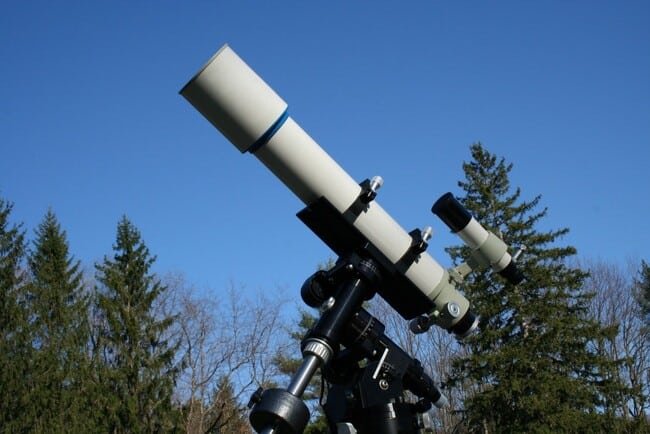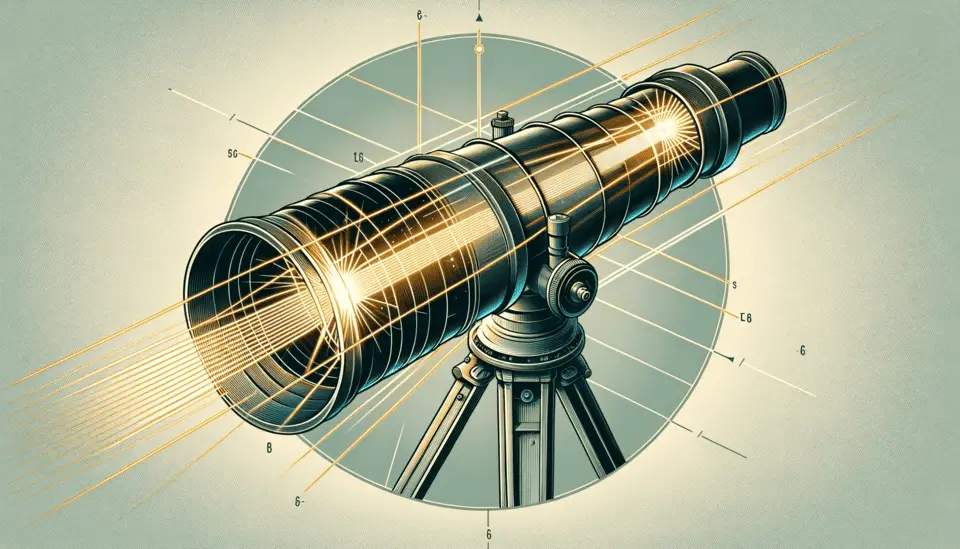The focal length of a telescope is a fundamental specification that every astronomer should consider when determining their telescope.
The focal length in a telescope is the distance from the lens or mirror to the point where light rays converge where we observe an image. It influences magnification and field of view, shaping the experience of viewing.
The focal length of a telescope largly determines the magnification of the image that the telescope produces. Longer focal length telescopes will produce a larger image of the object being observed, while a telescope with a shorter focal length will produce a smaller image. Additionally, the focal length also determines the telescope’s field of view. Telescopes with shorter focal lengths have wider field of views, while those with longer focal lengths have a narrower field of view.
So, what is it you need? Since understanding the focal length of a telescope is essential to selecting the right telescope for your needs, let’s keep reading.
The Basics of Focal Length
Focal length is a fundamental concept in telescopes. It plays a significant role in determining the instrument’s magnification and field of view. Simply put, focal length is the distance between the lens or mirror of a telescope and the point where the light rays converge to form an image.
In Telescopic Observation
In telescopic observation, a telescope’s focal length determines the magnification and the longer the focal length, the greater the magnification. However, higher magnification comes at the cost of a narrower field of view, meaning less of the sky can be observed at once. Think planet observing for a longer focal length.
On the other hand, shorter focal lengths provide a wider field of view, allow for a bigger slice of the sky to be observed at once. However, shorter focal lengths result in lower magnification, which may not be suitable for certain observations. Think of observing nebulae for a shorter focal length.
It is important to note that the aperture of a telescope also plays a role in determining the quality of the image. A larger aperture allows more light to enter the telescope, resulting in a brighter and sharper image. However, a larger aperture also increases the cost and size of the telescope.
Understanding the basics of focal length is crucial for selecting the right telescope for a particular observation. By considering the focal length, aperture, and field of view, astronomers can choose a telescope that meets their needs and preferences.
How Focal Length Shapes Your Viewing Experience
A longer focal length increases magnification, making distant objects appear closer and more significant. However, this also means a narrower field of view and a smaller sky area visible at once. On the other hand, shorter focal length results in a wider field of view, allowing for a larger area of the sky to be visible at once. However, this also means lower magnification and objects appearing smaller.

When selecting a telescope with a certain focal length, it’s essential to consider the desired viewing experience. For example, a longer focal length may be ideal for observing planets and other small objects in detail. A shorter focal length may be better suited for viewing larger objects such as star clusters and galaxies.
It’s also worth noting that the eyepiece used with the telescope can further impact the viewing experience. Different eyepieces have different focal lengths and can result in different magnifications and fields of view. See this about magnification.
Overall, understanding how focal length shapes the viewing experience of a telescope is important in selecting the right telescope for individual needs and preferences.
Short vs Long Focal Length Telescopes, Pros and Cons
Telescopes come in different sizes and focal lengths. Focal length is the distance between the lens or mirror and the point where the light rays converge. (where we focus our eyepieces) To form an image. Short focal length telescopes have a focal length of less than 1000mm, while long focal length telescopes have a focal length of more than 1000mm.
Pros of Short Focal Length Telescopes
Short focal-length telescopes are generally more compact and lightweight than their long focal-length counterparts. They are also easier to set up and transport, making them ideal for beginners or those who want to take their telescope on the go. Short focal length telescopes have a wider field of view, which means they can capture more of the night sky in one image. This makes them great for observing large objects like galaxies and star clusters.
Cons of Short Focal Length Telescopes
Short focal length telescopes have a smaller magnification and are not ideal for observing small or distant objects like planets and stars. They also have a shorter focal ratio, which means they have a smaller aperture and are not as good at capturing faint objects or details.
Pros of Long Focal Length Telescopes
Long focal length telescopes have a higher magnification and are ideal for observing small or distant objects like planets and stars. They have a longer focal ratio, which means they have a larger aperture and are better at capturing faint objects or details. Long focal-length telescopes are also great for astrophotography, as they can capture more detail in a single image.
Cons of Long Focal Length Telescopes
Long focal length telescopes are generally larger and heavier than short focal length telescopes, making them more difficult to set up and transport. They also have a narrower field of view, which means they can only capture a small portion of the night sky in one image. This makes them less ideal for observing large objects like galaxies and star clusters.
Overall, the choice between a short or long focal-length telescope depends on the observer’s preferences and needs. Beginners may prefer a short focal-length telescope for its ease of use and wider field of view, while experienced observers may prefer a long focal-length telescope for its higher magnification and ability to capture more detail.
Astrophotography, well, it depends on what you are taking a picture of. A shorter focal length is best for imaging space, while a longer one is best to try and get planets, just like with the eye.

The Interplay Between Focal Length and Telescope Eyepieces
The focal length of a telescope, crucial in determining its magnifying power, works in tandem with the eyepiece’s focal length. This relationship is key for astronomers as it dictates the overall magnification, calculated by dividing the telescope’s focal length by the eyepiece’s focal length. For example, a telescope with a 1200mm focal length and a 25mm eyepiece provides a magnification of 48x.
This interplay between focal length and eyepieces allows astronomers to customize their viewing experience. Shorter focal length eyepieces offer higher magnification for detailed planetary viewing, while longer ones yield a broader field of view, ideal for observing larger celestial objects like nebulae and galaxies.
Selecting the right combination tailors the telescope for specific observational needs, from wide-field sky surveys to focused lunar exploration.
What Is The Average Focal Length?
The average focal length of a telescope varies widely based on the type and purpose of the telescope. However, I can categorize common types of telescopes and their typical focal lengths. It’s important to note that these are approximate values and can vary based on specific models and manufacturers.
| Telescope Type | Typical Focal Length Range |
|---|---|
| Refractors | 400mm to 1000mm |
| Reflectors | 900mm to 2000mm |
| Schmidt-Cassegrains | 1500mm to 2500mm |
| Maksutov-Cassegrains | 1000mm to 3000mm |
| Dobsonian | 1200mm to 2000mm |
- Refractors: Ideal for beginners and for observing the moon and planets. They typically have shorter focal lengths.
- Reflectors: Commonly used for deep-sky observation. They have moderate to long focal lengths.
- Schmidt-Cassegrains: Versatile and compact, they have long focal lengths, making them excellent for detailed planetary viewing.
- Maksutov-Cassegrains: Known for their long focal lengths in a compact design, they are excellent for high-resolution imaging.
- Dobsonian: A type of reflector telescope known for its simplicity and large aperture, often used for deep-sky observation.
Each type of telescope serves different observational needs, and the focal length plays a significant role in determining what an observer can see and how they see it.
Choosing the Right Focal Length for Your Astronomical Interests
This is easy, really, but it is hard to explain due to the unknowns. When explaining it, for example, I don’t know your aperture, target of observation, and eyepiece size. Does this make it difficult to explain, like a trifecta or maybe a quadratic equation? Anyway, I hope you get the picture.
The main equation that becomes important is the f-ratio equation. Which is the Focal length divided by the Aperture diameter. It is usually performed in ‘mm’. Learn more about how this comes into play with a telescope.
I think this is why you’ll find most astronomers with more than one telescope? It’s essential to consider your astronomical interests when choosing the right focal length for your telescope. If you are just starting out, just get a good brand name that you can afford, you can upgrade with accessories like a Barlow lens to increase the focal length. Better quality eyepieces and sizes help, too.


